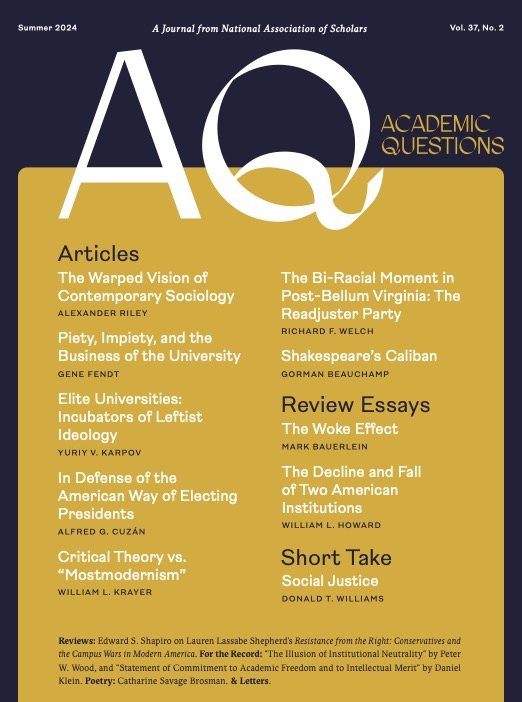The University of West Florida. What follows is a slightly edited version of remarks delivered at a debate on the Electoral College held in the Commons Auditorium of the university and live-streamed on zoom on October 11, 2023.
In the wee hours of November 9, 2016, many Americans were shocked, driven to tears, even enraged when it dawned on them that it was not Hillary Clinton, the candidate who had received the largest number of individual votes across the country, but Donald Trump, the winner of the popular vote in 30 states. This raised anew the issue of why the United States still uses a method for choosing its chief executive that many consider archaic, a relic from a distant past, or worse.1 My opinion is very different, and in what follows I defend the American institution of electing presidents by states.
First, a few fundamentals, starting with the very name of this country, for it is redolent of constitutional and political meaning. It first appeared in the Declaration of Independence, which begins, “The unanimous Declaration of the thirteen united (sic) States of America,” and concludes, “We therefore, the Representatives of the united States of America, in General Congress, Assembled . . . .” Two months later, on September 9, 1776, the Second Continental Congress officially adopted The United States of America as the name for the new country that was aborning.
Fifty-six delegates signed the document, but it was not a unanimity of the members of the Congress as individuals that carried the day, but of the states that sent them to Philadelphia. Each state usually deputized more than one delegate to represent it, and a majority of the members of each state contingent decided how the state would vote. This is known as the unit rule. Like the Continental Congress, the Constitutional Convention that met in Philadelphia in the summer of 1787 was an assembly of states and it, too, voted by states. In turn, the proposed Constitution establishing the federation was ratified separately by conventions elected within each of the states to consider the proposed union. Within a year, eleven had ratified it. The last of the original thirteen, North Carolina and Rhode Island, did so, in 1789 and 1790, respectively. In 1791, Vermont became the first state to petition for admission, and Alaska and Hawaii were the last, in 1958.
In sum, at the founding, thirteen independent colonies voted to form a “more perfect union,” as the preamble of the Constitution proclaims, and they did so voting separately, by state. Similarly, as befits a federal polity, to amend the Constitution requires the assent of three fourths of the states, each voting separately. Is it any wonder, then, that the method that the founders came up with for the election of the president of the United States, the single most important office of the federation, would conform to the same pattern?
Which brings us to the so-called “Electoral College.” The phrase is not found in the Constitution. It is nothing but a metaphor to describe the process for electing the president by states. Here is what the Constitution, as amended, says:
Each State shall appoint, in such Manner as the Legislature thereof may direct, a Number of Electors, equal to the whole Number of Senators and Representatives to which the State may be entitled in the Congress: The Electors shall meet in their respective states and vote by ballot for President and Vice-President, one of whom, at least, shall not be an inhabitant of the same state with themselves..
Next, the Constitution provides a backstop in case no person has a majority of elector votes: The House of Representatives shall choose from no more than three of the candidates with the most votes; but, and here comes the unit rule again,
[I]n choosing the President, the votes shall be taken by states, the representation from each state having one vote; a quorum for this purpose shall consist of a member or members from two thirds of the states, and a majority of all the states shall be necessary to a choice.
The appearance of political parties effectively did away with any discretion the founders may have envisioned for the electors. As the system evolved, at their national conventions each political party nominates a “ticket” consisting of a candidate for president and a candidate for vice-president and, in each state, a set of electors pledged to vote for their candidates. Except in Maine and Nebraska, in all other states and the District of Columbia, the ticket that wins the most votes in a state sweeps the number of electors assigned to that state. Then, whichever presidential candidate wins a majority of votes from the total cast by the electors from the 50 states and the District of Columbia is declared president. If the election is thrown into the House, which has happened only twice, in 1800 and 1824, long before the present two-party system became consolidated, every state’s delegation presumably would vote according to which party a majority of its members belonged.
In light of the history of the founding, it makes perfect sense why the framers provided for the election of the president by states. It makes even more sense once we recognize that the presidency is not a standalone feature of the federal constitutional design, but an integral part of it. As then-Senator John F. Kennedy said in 1956 when he rose to speak in opposition to changing the manner of electing the president, “we are talking about a whole solar system of government. If it is proposed to change the balance of power of one of the elements of the solar system, it is necessary to consider the others.” The trouble is, while some effects are foreseeable, others are not.
Electing presidents by states necessitates that candidates for president take into account the interests, opinions, preferences and lifestyles of voters who live, work, raise families, and bury their dead in very different parts of the country to which they are attached, many through generations. I dare say that it is no accident that of the thirty-six presidential elections since 1880, the winning presidential ticket won a majority of the states thirty-two times, tied twice (Garfield and Biden) and came up short only on two occasions (JFK by two states, and Jimmy Carter by four). On average, victorious candidates chalk up 70 percent of elector votes.
Compare that to Hillary Clinton’s performance in 2016. She won only 20 states comprising 43 percent of elector votes. Her vaunted margin of almost three million individual votes over Mr. Trump is accounted for entirely by lopsided totals in only five counties, all in California: Los Angeles (2, 464, 364 vs. 769, 743), San Diego (735,476 vs. 477,766), Alameda (514,842 vs. 95,922), Santa Clara (511, 684 vs. 144,826) and San Francisco (345,084 vs. 37,688). It does not take a great deal of perspicacity to note that whatever advantages these places offer, representative of the rest of the country they are not.
Earlier I quoted then-Senator John Kennedy’s “solar system” metaphor for the American system of government in which the presidency is an integral part of the federal structure. Indeed, the structure is an intricate one and includes three branches of government with overlapping jurisdictions, different tenures in office, a bi-cameral congress, staggered elections for senators, and a judiciary whose members are appointed effectively for life. The system incorporates two principles of representation. One is that of the individual voter. Every vote counts the same as every other within the states in which they are cast and pooled. The other is the federal principle of equal representation of the states in the U.S. Senate and, as we have seen, in the election of the president.
The system operates as the framers intended, with checks and balances, only it does so principally through the party system. Since 1880, 55 percent of presidential winners have been Republicans while, during the same period, Democrats have controlled the House about 60 percent of the time and the Senate approximately 55 percent of the time. Thus, divided government has been, though not the rule, frequent enough (and with increasing frequency since 1994) to check overweening ambition or overreach by one or the other of the elected branches.
Not to be neglected, over the last century Democrats and Republicans are almost perfectly evenly distributed among governors, even as entire regions have shifted from Republican to Democrat (as in New England) and Democrat to Republican (as in the South). Thus, the system displays a partisan balance through nearly one and a half centuries. Whether this is the conscious intention of the voters or some mechanistic phenomenon of action-reaction, I leave to others to speculate. All I wish to point out is that the system works just as the framers expected, even if they had not anticipated the emergence of mass parties as the principal balancing mechanism.
It is this “solar system of government” that will be upset by those who seek to do away with electing the president by states. As Kennedy said, changes in the manner in which the president is elected will necessitate changes in other parts. Some of those changes are predictable, but there may be others, even more significant, that are unforeseen and will not be recognized until it is too late to reverse course.
Some questions immediately come to mind. If the presidency is detached from the states, how will candidates be nominated? Would state primaries and caucuses continue to make political sense? Will states and localities continue to register voters, administer elections, and certify the results? Or will a national administration, perhaps the Federal Election Commission, do that?
In eight of the last thirty-six and two of the last six presidential elections only two percentage points or less separated the two principal candidates. One of those was in 2000, where the outcome in one state, Florida, held the outcome hostage for weeks. What would happen if charges of fraud or voter suppression were bandied about in a national election? Would the courts again be drawn into those disputes, further politicizing the judiciary?
In thirteen of the last thirty-six elections, and four of the last eight, the winning candidate received less than 50 percent of the vote. Nevertheless, these presidents averaged 60 percent of state elector votes, so their victories were secure from other than narrowly, not to say nakedly partisan attempts to undermine their legitimacy. If the popular vote were all there was, challenges to the results aside, would the legitimacy of a plurality, not a majority president, be undermined? This will prompt calls for a second round, a run-off between the two (or three) top vote getters, if no one wins an absolute majority. But then, wouldn’t that create incentives for many candidates to enter the fray to ensure no one does and hence acquire leverage to extract concessions from those going into the next round in exchange for delivering votes, just the sort of “intriguing” the founders worried about and Andrew Jackson denounced as a “corrupt bargain”? Would more candidates without prior government experience but with wide recognition earned in sports, entertainment, or business be more likely to run? New entrants will likely do so under the flag of a new electoral vehicle made to order just for them, as it happens in France and Latin America. Would the historic two-party system survive even a single triumph of one such “third party” candidate?
Once the presidency is unmoored from the states, which means, in effect, from the federation, it will rise and float above all other offices, becoming ever more imperial, even plebiscitary, aided by national referendums on issues the White House will want to put on the table, if only on an advisory basis, to bypass the Congress. Beyond that, more far-reaching constitutional changes will be contemplated, proposed, and propagandized. Equal representation of the states will be the next target.2 Lifetime appointments for the judiciary and judicial review will also be called into question. And so, one institution at a time, the federal system will be disemboweled. It might take two or three generations, but in due course the Constitution itself will become a dead letter, kept under glass at the National Archives as a curious relic, no longer giving life to our republic.
Alfred G. Cuzán is Distinguished University Professor, Department of Government, The University of West Florida. This article is a slightly edited version of remarks delivered at a debate on the Electoral College held in the Commons Auditorium of the university and live-streamed on Zoom on October 11, 2023.
1 See, e.g., Clifton B. Parker, “National popular vote far better than Electoral College system for choosing presidents, Stanford professors say,” Stanford News, April 8, 2016. The author writes, “Stanford political experts say it is time to abolish the Electoral College in favor of a single national popular vote where all votes count equally, Stanford political experts say.” Doug McAdam, professor of sociology, said that “‘No principle is more fundamental to the theory of democratic governance than political equality; that is, the idea that every citizen’s voice or views should count as much as anyone else’s,’ said McAdam. The current system violates this principle.” Jack Rakove, professor of history and political science also weighed in: ‘The electoral weight of the citizen should not vary from one place to another based on the distorting effect of the ‘senatorial bump,’ which refers to the overrepresentation of small states in the Electoral College due to their two Senate-based electors, he said. Rakove said the last three U.S. presidents have all suffered from attacks on the legitimacy of their election fueled in part by the perception of a nation largely divided into red and blue states. ‘If we think of the electoral map as a tableau of national division, we form a disparaging view of the victor’s presidential authority right from the outset’, he said. However, if the winning candidate was perceived to be the victor of a truly national election, partisanship might decrease, Rakove said.”
An unsigned December 1, 2020 item at Purdue University blog quotes political science professor Dr. James McCann: “‘The Electoral College creates distortions in political campaigns and voting outcomes most people would find objectionable,’ says Dr. James McCann, political science professor at Purdue. ‘Smaller states are overrepresented, and states that aren’t ‘swing states’ (like Indiana) get little to no attention from presidential and vice-presidential candidates during campaigns’.” “‘Furthermore, the fact that a candidate who leads in the popular vote would not become the next president seems illegitimate on the face of it,’ says Dr. McCann.” Another political science professor at the same institution, Dr. Rosalee Clawson, “agrees the current system is deeply flawed. ‘The Electoral College is a relic and is no longer functional in our modern democracy,’ says Dr. Clawson.”
2 The anonymous author of the Purdue Policy Research Institute Blog is there already. “Of course, the Electoral College isn’t the only example where America’s distribution of political power is skewed. Consider the Senate, where Wyoming’s 600,000 residents have the same representative power as California’s 39.5 million. More than the Electoral College may have to change to ensure equal representation across the country. Moving forward, more and more U.S. citizens are demanding the same thing: let the majority rule, or, in other words, make every vote in every state count.”
Photo by rawpixel.com on Adobe Stock














